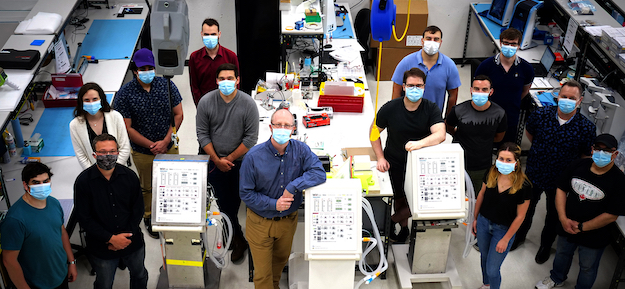
Medical Design in the time of COVID
By Treena Hein
General Medical editor pickStarFish Medical pulls off near impossible design feat with development of the Winnipeg Ventilator 2.0.

John Walmsley, StarFish Medical’s Executive VP of Strategic Relationships, with the Winnipeg Ventilator 2.0 and the StarFish crew who helped design it. (Photo credit: StarFish Medical)
Turns out that’s no sweat for StarFish Medical, Canada’s largest full-service medical device design company, based in Toronto and Victoria, BC and now entering its third decade in operation. In September, StarFish’s Winnipeg Ventilator 2.0 received Health Canada COVID-19 Medical Device Authorization, after being selected for financial support by NGen Canada, a supercluster agency, that in March announced $50 million to support the development of medical solutions to fight Covid-19.
The design of Winnipeg Ventilator 2.0 is based on a prototype created by Dr. Magdy Younes at the University of Manitoba in Winnipeg about 25 years ago. At the time, that Winnipeg 1.0 design was licensed to a major manufacturer, which made tens of thousands of units and deployed them in hospital ICUs around the world during the 1990s and 2000s, and extensively during the SARS epidemic in 2003.
However, the design and manufacture of next-generation 2.0 version this year was not simply an update. StarFish engineers had to sidestep the unprecedented pressure on the medical device supply chain to design their ventilator with non-medical components they could find in Canada.
This colossal effort, with people working 12-hour days, seven days a week for months, has been undertaken by 106 StarFish employees and over 100 other people at key vendors like Dometic, Advanced Test Automation, Yorkville, Dorigo Systems, Powersonic Industries, EM Dynamics and Celestica. In the end, Dr. Younes tested the updated version of his ventilator and declared it “a masterpiece.”
Components Led Design
Ventilators are all about precise airflow. Most ventilators use an impeller/turbine for overall flow, but the Winnipeg 2.0 design employs a “frictionless” piston design.
The piston is precision-machined so its diameter is a fraction of a millimeter smaller than the cylinder’s diameter. This eliminates the need for a physical seal, reduces resistance to piston motion and makes it possible to obtain very high flow rates.
With that nailed down, the StarFish team then focused on the valves. The oxygen gas mixing system in a typical ventilator is controlled with a proportioning valve that provides continuous control, explains John Walmsley, StarFish Executive VP of Strategic Relationships.
“We used a solenoid valve, which is typically found in many types of process control and therefore widely available, but it’s either open or closed,” he says. “We needed to have our firmware control the valve timing so that, in the end, the same control of oxygen mixing is achieved.”
“It was tricky, but the fact that we had complete control with the firmware enabled us to make rapid progress with making the firmware and the hardware work together.”
Indeed, most other companies making new ventilators for COVID-19 used existing operating systems, but the StarFish team wrote its firmware from scratch in the C programming language so as to have total control and therefore total confidence in the machine’s safety. This confidence needed to extend from very precise control of the supplied gas mixture to the capacity of the 2.0 design to precisely and reliably respond to each individual patient’s changing needs.
“There are many pressure sensors, redundancies, alarms and so on in a ventilator,” says Walmsley, “and we wanted to design the firmware architecture from the ground up so that we could control all this and know it would validate against the necessary standards.”
This, again, all ties back to the solenoid valve. The valve first chosen by StarFish turned out to be too slow. It’s lengthy feedback response time created too many challenges in the control algorithm. Walmsley says that while there were many ways of fixing the situation, to save significant time on the firmware end, the team chose a faster valve.
On the pressure sensor front, design team implemented a rapid search between a few contenders but, eventually, a sensor with timely availability was chosen. Looking at other parts, the control panel of the 2.0 version is produced by a music amplifier manufacturer and the piston pump comes from a manufacturer that commonly makes pumps for RVs and boats.
The pneumatics come from the industrial control and automotive sectors. In a few cases, StarFish found components that would work, but the suppliers were required to upgrade the quality to meet medical grade standards.
Miraculously, StarFish made their submission for regulatory approval in three months, a process that normally takes three years. Production started at Celestica in October and thousands of units are on the way. While the actual work on this project was unusual for StarFish, it’s also been atypical in terms of conflicting emotions of the team members.
“In the summer, we weren’t sure how much ventilators might be needed this fall and so it’s been a little strange to work on a product that you actually hope won’t be needed,” Walmsley says. “But with the second wave, it looks like many ventilators will perhaps be needed, and to provide a machine that will helps save lives is very satisfying for everyone involved.”
www.starfishmedical.com
Treena Hein is a Pembroke, ON-based freelancer
